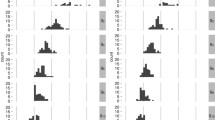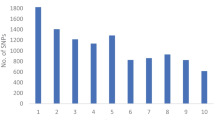Abstract
Molecular-marker loci were used to investigate the adaptation differences between highland and lowland tropical maize. An F2 population from the cross of two inbred lines independently derived from highland and lowland maize germplasm was developed, and extracted F3:4 lines were phenotype in replicated field trials at four thermally diverse tropical testing sites, ranging from lowland to extreme highland (mean growing season temperature range 13.2–24.6°C). Traits closely related with adaptation, such as biomass and grain yield, yield components, days from sowing to male and female flowering, total leaf number, plant height and number of primary tassel branches (TBN), were analyzed. A large line × environment interaction was observed for most traits. The genetic basis of this interaction was reflected by significant, but systematic, changes from lowland to highland sites in the correlation between the trait value and genomic composition (designated by the proportion of marker alleles with the same origin). Joint analysis of quantitative trait loci (QTLs) over sites detected 5–8 QTLs for each trait (except disease scores, with data only from one site). With the exception of one QTL for TBN, none of these accounted for more than 15% of the total phenotypic variation. In total, detected QTLs accounted for 24–61% of the variation at each site on average. For yield, yield components and disease scores, alleles generally favored the site of origin. Highland-derived alleles had little effect at lowland sites, while lowland-derived alleles showed relatively broader adaptation. Gradual changes in the estimated QTL effects with increasing mean site temperature were observed, and paralleled the observed patterns of adaptation in highland and lowland germplasm. Several clusters of QTLs for different traits reflected the relative importance in the adaptation differences between the two germplasm types, and pleiotropy is suggested as the main cause for the clustering. Breeding for broad thermal adaptation should be possible by pooling genes showing adaptation to specific thermal regimes, though perhaps at the expense of reduced progress for adaptation to a specific site. Molecular marker-assisted selection would be an ideal tool for this task, since it could greatly reduce the linkage drag caused by the unintentional transfer of undesirable traits.
Similar content being viewed by others
Author information
Authors and Affiliations
Additional information
Received: 10 October 1998 / Accepted: 9 April 1999
Rights and permissions
About this article
Cite this article
Jiang, C., Edmeades, G., Armstead, I. et al. Genetic analysis of adaptation differences between highland and lowland tropical maize using molecular markers. Theor Appl Genet 99, 1106–1119 (1999). https://doi.org/10.1007/s001220051315
Issue Date:
DOI: https://doi.org/10.1007/s001220051315




